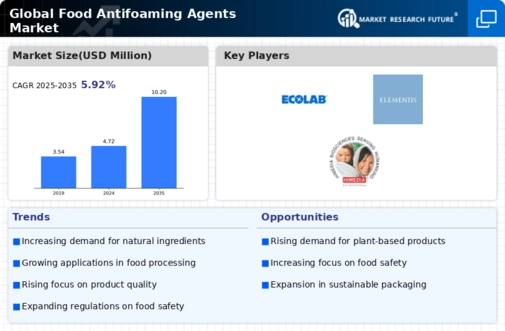Food Antifoaming Agents Size
Food Antifoaming Agents Market Growth Projections and Opportunities
The Food Antifoaming Agents market is influenced by a combination of factors that collectively shape its growth and market dynamics. One primary driver is the expansion of the food processing industry, where antifoaming agents play a crucial role in controlling and preventing foam formation during various manufacturing processes. As food and beverage manufacturers strive for efficiency and quality in their production processes, the demand for antifoaming agents rises to address challenges related to foam, which can negatively impact the efficiency and consistency of manufacturing operations.
Technological advancements and innovations contribute significantly to the Food Antifoaming Agents market. Ongoing research and development efforts focus on enhancing the effectiveness and versatility of antifoaming agents, allowing them to cater to a broader range of food processing applications. The development of specialized antifoaming agents tailored for specific food products and processes reflects the market's adaptability and responsiveness to the evolving needs of the food industry.
Globalization and international trade are pivotal factors influencing the Food Antifoaming Agents market. As food production becomes increasingly globalized, there is a growing demand for antifoaming agents that meet diverse regulatory standards and processing requirements across different regions. Companies operating in the market must navigate varied regulatory landscapes and cultural nuances to provide effective antifoaming solutions that align with the specific needs of food manufacturers worldwide.
The focus on operational efficiency and cost-effectiveness is another significant factor in the Food Antifoaming Agents market. Foam-related issues in food processing can lead to increased production costs, downtime, and quality control challenges. Antifoaming agents offer a practical solution to these problems, allowing manufacturers to optimize their production processes and reduce overall costs. The market benefits from the emphasis on efficiency and cost-effectiveness as key considerations in the food manufacturing sector.
Environmental and sustainability considerations are emerging factors influencing the Food Antifoaming Agents market. As the food industry places a greater emphasis on sustainability and eco-friendly practices, there is a growing demand for antifoaming agents that meet environmental standards. Companies are exploring formulations that are biodegradable, environmentally friendly, and produced using sustainable practices, aligning with the broader trend of corporate responsibility and environmental consciousness.
Despite the positive trends, challenges exist in the Food Antifoaming Agents market. The need for clear labeling and consumer awareness regarding the use of antifoaming agents in food products poses challenges for manufacturers. Striking a balance between effective foam control and consumer expectations for clean-label and natural products requires ongoing innovation and communication efforts.







Leave a Comment